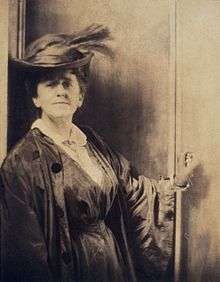Adolph de Meyer
| Adolph de Meyer | |
|---|---|
 | |
| Born |
1 September 1868 Paris |
| Died |
6 January 1946 (aged 77) Los Angeles |
| Occupation | Photographer |
| Known for | Celebrity portrait photographs |
| Spouse(s) | Olga de Meyer |
Baron Adolph de Meyer (1 September 1868[1] – 6 January 1946) was a photographer famed for his photographic portraits in the early 20th century, many of which depicted celebrities such as Mary Pickford, Rita Lydig, Luisa Casati, Billie Burke, Irene Castle, John Barrymore, Lillian Gish, Ruth St. Denis, King George V of the United Kingdom, and Queen Mary. He was also the first official fashion photographer for the American magazine Vogue, appointed to that position in 1913.
Background
Reportedly born in Paris and educated in Dresden, Adolphus Meyer was the son of a German Jewish father and Scottish mother—Adolphus Louis Meyer and his wife, the former Adele Watson.[2][3]
In 1893 he joined the Royal Photographic Society and moved to London in 1895.
He used the surnames Meyer, von Meyer, de Meyer, de Meyer-Watson, and Meyer-Watson at various times in his life.[4] From 1897 he was known as Baron Adolph Edward Sigismond de Meyer, though some contemporary sources list him as Baron Adolph von Meyer and Baron Adolph de Meyer-Watson.[5][6]
In editions dating from 1898 until 1913, Whitaker's Peerage stated that de Meyer's title had been granted in 1897 by Frederick Augustus III of Saxony, though another source states "the photographer inherited it from his grandfather in the 1890s".[7] Some sources state that no evidence of this nobiliary creation, however, has been found.[8]
Marriage
On 25 July 1899, at Holy Trinity Church, Sloane Street, Cadogan Square, in London, England, de Meyer married Donna Olga Caracciolo, an Italian noblewoman who had been divorced earlier that year from Nobile Marino Brancaccio; she was a goddaughter of Edward VII.[9][10] The couple reportedly met in 1897, at the home of a member of the Sassoon banking family, and Olga would be the subject of many of her husband's photographs.
The de Meyers' marriage was one of marriage of convenience rather than romantic love, since the groom was homosexual and the bride was bisexual or lesbian.[11][12] As Baron de Meyer wrote in an unpublished autobiographical novel, before they wed, he explained to Olga "the real meaning of love shorn of any kind of sensuality". He continued by observing, "Marriage based too much on love and unrestrained passion has rarely a chance to be lasting, whilst perfect understanding and companionship, on the contrary, generally make the most durable union."[13]
After the death of his wife in 1930/31, Baron de Meyer became romantically involved with a young German, Ernest Frohlich (born circa 1914), whom he hired as his chauffeur and later adopted as his son. The latter went by the name Baron Ernest Frohlich de Meyer.[14][15][16]
Career

From 1898 to 1913 de Meyer lived in fashionable Cadogan Gardens, London, and between 1903 and 1907 his work was published in Alfred Stieglitz's quarterly Camera Work. Cecil Beaton dubbed him "the Debussy of photography". In 1912 he photographed Nijinsky in Paris.
On the outbreak of World War I, the de Meyers, who in 1916 took the new names of Mahrah and Gayne, on the advice of an astrologer, moved to New York City, where he became a photographer for Vogue from 1913–21, and for Vanity Fair. In 1922 de Meyer accepted an offer to become the Harper's Bazaar chief photographer in Paris, spending the next 16 years there.
On the eve of World War II in 1938, de Meyer returned to the United States.
He died in Los Angeles in 1946, his death being registered as 'Gayne Adolphus Demeyer, writer (retired)'.[17] Today, few of his prints survive, most having been destroyed during World War II.
Sources
References
- ↑ View on the online birth certificate, number 729: Declaration of birth was made on the 3 September, but the parents declared the child was born on 1 September at 10:00 AM
- ↑ Adolphus Louis Meyer is given as the name of Baron de Meyer's father on his 1899 marriage license, found through ancestry.com.
- ↑ Of Passions and Tenderness: Portraits of Olga by Baron de Meyer, Graystone Press, 1992, page 7.
- ↑ A circa-1900 photograph of his wife, Olga, bears the signature "Adolph Meyer", a signature he frequently used before adopting "De Meyer". See Of Passions and Tenderness: Portraits of Olga by Baron de Meyer, Graystone Press, 1992, page 111.
- ↑ The name "Baron A. de Meyer-Watson" is cited in Photograms of the Year: The Annual Review of the World's Pictorial Photographic Work, 1899, page 188
- ↑ Who's Who in England, 1905
- ↑ Of Passions and Tenderness: Portraits of Olga by Baron de Meyer (Greystone Books, 1992), page 6
- ↑ Anthony Camp, Royal Mistresses and Bastards: fact and fiction 1714-1936 (London, 2007) 357-8.
- ↑ British marriage records available through Freebmd.rootsweb.com state the bride and groom as Maria Beatrice Olga Brancaccio, Princess de Moavero, and Baron Adolphus Edward Sigismund von Meyer.
- ↑ Of Passions and Tenderness: Portraits of Olga by Baron de Meyer, Graystone Books, 1992
- ↑ American Book Collector, Volume 2, 1981, page 15
- ↑ History of Art: Adolf de Meyer
- ↑ Of Passions and Tenderness: Portraits of Olga by Baron de Meyer (Graystone Books, 1992), pages 17 and 105.
- ↑ John Hannavy, Encyclopaedia of Nineteenth-Century Photography, Volume 1, page 396
- ↑ A Singular Elegance: The Photographs of Baron Adolph de Meyer, International Center for Photography, 1994
- ↑ "Hold Alien in Officer Garb", The New York Times, 16 December 1941
- ↑ Authorities cited in Anthony Camp, op.cit., 358.
| Wikimedia Commons has media related to Adolf de Meyer. |